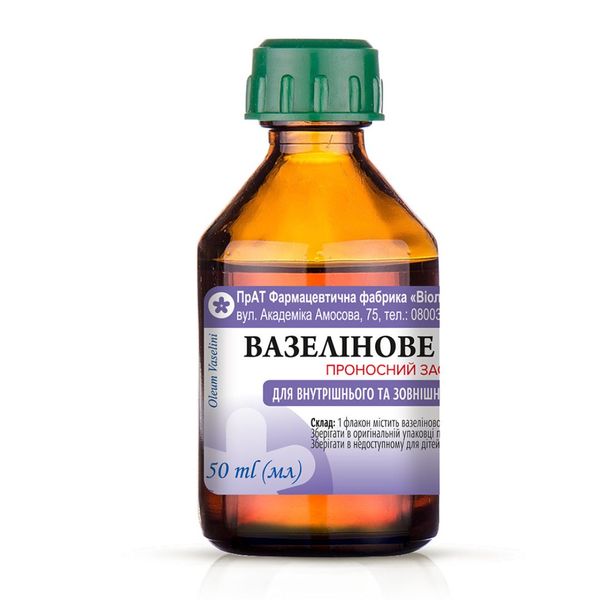|
Quantity
|
Out of stock
|
||
|
|
|||
Vaseline oil is made from carbohydrates obtained from petroleum products. The substance is practically not absorbed into the systemic bloodstream through the skin and intestines.
It can be used by adults and children, women during pregnancy, as it does not cause irritation and allergies. It has a softening effect, promotes easy exit of feces from the intestines.
If you suffer from constipation, try Vaseline. When used internally, Vaseline softens feces, which greatly simplifies their passage through the intestines.
The product is also useful for excessively dry skin. When used externally, it softens the skin.
Vaseline oil can also be used before installing cups and performing various medical procedures.
For constipation, take 1-2 tablespoons of Vaseline during the day. When used externally, it is necessary to apply a thin layer of oil to the skin, rubbing it in lightly. Excess substance can be removed with a napkin.
Composition:
active ingredient: Vaseline;
1 bottle contains 25 ml or 50 ml of Vaseline.
Dosage form. Oil.
Main physicochemical properties: colorless transparent oily liquid, non-fluorescent in daylight.
Pharmacotherapeutic group.
Laxatives. ATX code A06A A01.
Pharmacological properties.
Pharmacodynamics.
Vaseline is a purified mixture of solid and liquid carbohydrates obtained from oil. When taken orally, without being absorbed, it softens feces and facilitates their passage through the intestines. When applied externally, it eliminates dry skin, and is practically not absorbed into the systemic bloodstream.
Pharmacokinetics.
Pharmacokinetics have not been determined.
Clinical characteristics.
Indications.
Inside - chronic constipation in adults. Externally - before using cups, with dry skin (including around natural openings), before carrying out medical procedures (lubricate the tip of the enema, gas outlet tube).
Contraindication.
Hypersensitivity to the drug. Do not use internally in acute inflammatory processes of the abdominal organs (appendicitis, peritonitis, gastric ulcer and duodenal ulcer, ulcerative colitis), hemorrhoids, during menstruation. Do not use in case of poisoning with phosphorus and organophosphorus compounds. Do not use internally simultaneously with fat-soluble anthelmintic agents (natamol, vermox, medamin, avermol).
Special safety measures.
Shake before use. If necessary, wipe off the oil with a cotton or gauze swab after application and wash with warm water and soap. After stopping the course of internal use, Vaseline oil may be released from the anus for some time and contaminate underwear, so it is recommended to use pads.
Interaction with other drugs and other types of interactions.
Enhances the side effects of fat-soluble and anthelmintic drugs.
Special features of use.
Use during pregnancy or breastfeeding.
The drug is contraindicated in pregnancy. During breastfeeding, use taking into account the benefit to the mother / risk to the child ratio, which is determined by the doctor.
Ability to influence the reaction rate when driving vehicles or other mechanisms.
No data.
Method of administration and dosage.
Prescribed to adults 1-2 tablespoons per day orally. The duration of use is determined by the doctor individually, depending on the therapeutic effect and tolerability of the drug. Externally - adults and children lubricate the skin with a thin layer, rubbing lightly.
Children.
Use in children only externally.
Overdose.
Not described. Side effects may increase.
Adverse reactions.
Long-term use may cause digestive disorders, nausea, anorexia, hypovitaminosis A, D, K, irritation and itching in the anal area. Allergic reactions are possible, including hyperemia, itching of the skin.
Shelf life:
5 years.
Storage conditions.
Store in the original packaging at a temperature not exceeding 25 ° C. Keep out of reach of children.
Packaging.
50 ml in a bottle; 1 bottle per package or without packaging. Bottles of 25 ml or 50 ml.
Leave category. Without prescription.
































